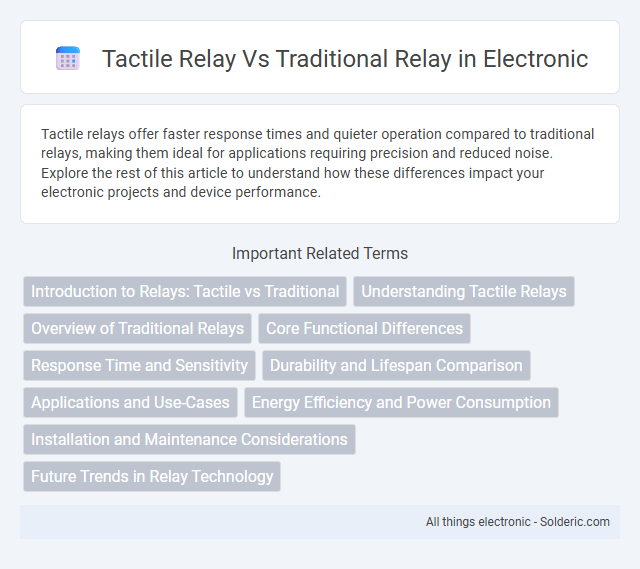Tactile relays offer faster response times and quieter operation compared to traditional relays, making them ideal for applications requiring precision and reduced noise. Explore the rest of this article to understand how these differences impact your electronic projects and device performance.
Comparison Table
| Feature | Tactile Relay | Traditional Relay |
|---|---|---|
| Operation Mechanism | Solid-state or low-profile tactile switch-based | Electromechanical switching with moving contacts |
| Size | Compact, typically small footprint | Bulkier, larger physical dimensions |
| Switching Speed | Faster, milliseconds response time | Slower due to mechanical movement |
| Lifetime | High durability, millions of cycles | Limited by mechanical wear, thousands to millions of cycles |
| Noise | Minimal or no audible click | Audible clicking sound during operation |
| Power Consumption | Low power, often solid-state | Higher power due to coil energization |
| Applications | Consumer electronics, compact devices | Industrial control, high power switching |
Introduction to Relays: Tactile vs Traditional
Tactile relays utilize a precise mechanical feedback mechanism that enhances user responsiveness and control, unlike traditional relays which rely on electromagnetic switching without tactile feedback. Traditional relays are often bulkier and slower, suitable for high-power applications, whereas tactile relays are compact and ideal for sensitive, low-voltage circuits requiring manual or automated interaction. The choice between tactile and traditional relays depends on factors such as response time, size constraints, and the need for physical feedback in electrical switching systems.
Understanding Tactile Relays
Tactile relays offer enhanced user feedback through a distinct click or vibration when activated, improving operational certainty compared to traditional relays. These relays incorporate built-in mechanisms that provide physical feedback, enabling precise control in applications requiring user interaction or monitoring. Understanding tactile relays is essential for selecting components in systems prioritizing ergonomic interface design and reliability.
Overview of Traditional Relays
Traditional relays use electromagnetic coils to mechanically switch contacts, enabling electrical isolation between control and load circuits. They are reliable for various applications, including automotive, industrial machinery, and home appliances, but tend to have slower switching speeds and limited lifespans due to mechanical wear. Your choice of relay should consider these factors along with current and voltage specifications for optimal performance.
Core Functional Differences
Tactile relays incorporate a built-in tactile feedback mechanism that provides physical confirmation of switching, enhancing user interaction and reliability in control applications. Traditional relays rely solely on electromagnetic switching without any tactile response, making them less intuitive for manual operation. This core functional difference impacts the efficiency and usability in systems requiring direct human engagement or precise feedback during switching events.
Response Time and Sensitivity
Tactile relays offer significantly faster response times compared to traditional relays, often activating within milliseconds due to their precise electromagnetic mechanisms. The enhanced sensitivity of tactile relays allows them to detect lower voltage signals, ensuring quicker and more accurate switching performance in your electronic applications. In contrast, traditional relays generally exhibit slower actuation speeds and require higher voltage thresholds, which may limit their responsiveness and sensitivity in delicate circuits.
Durability and Lifespan Comparison
Tactile relays offer enhanced durability due to solid-state components that resist mechanical wear, resulting in a significantly longer lifespan compared to traditional relays that rely on moving parts prone to degradation. The absence of physical contacts in tactile relays minimizes electrical erosion and contact bounce, extending operational reliability in demanding environments. Your choice of relay can impact maintenance frequency and system downtime, with tactile relays providing superior longevity and consistent performance over millions of cycles.
Applications and Use-Cases
Tactile relays excel in applications requiring precise physical feedback and manual operation, making them ideal for user interfaces in industrial machinery, automotive controls, and home automation systems. Traditional relays are preferred in high-power switching, motor control, and electrical isolation due to their robust handling of heavy electrical loads. Your choice between tactile and traditional relays depends on whether manual control or high current capacity is paramount for the specific use-case.
Energy Efficiency and Power Consumption
Tactile relays consume significantly less power compared to traditional electromagnetic relays due to their solid-state design, which eliminates the need for continuous coil energization. This energy efficiency translates to lower operational costs and reduced heat generation in your electrical systems. Choosing tactile relays enhances overall power management, especially in applications where minimizing energy consumption is critical.
Installation and Maintenance Considerations
Tactile relays offer easier installation with plug-and-play designs, reducing wiring complexity compared to traditional relays that often require manual terminal connections. Maintenance for tactile relays is simplified due to modular components that can be quickly swapped, minimizing downtime, whereas traditional relays may demand more time-consuming testing and replacement procedures. Your choice will impact long-term service efficiency and operational reliability in applications requiring frequent relay interventions.
Future Trends in Relay Technology
Tactile relays are increasingly favored over traditional electromagnetic relays due to their compact size, faster switching speeds, and enhanced durability in harsh environments. Future trends in relay technology emphasize the integration of solid-state and tactile mechanisms to improve energy efficiency and reliability in smart grid and IoT applications. Advancements in materials science are expected to further reduce contact wear, enabling longer lifespans and more consistent performance in high-frequency switching scenarios.
Tactile Relay vs Traditional Relay Infographic

 solderic.com
solderic.com